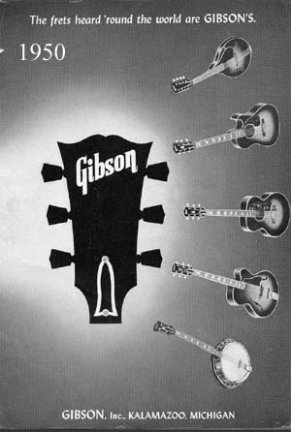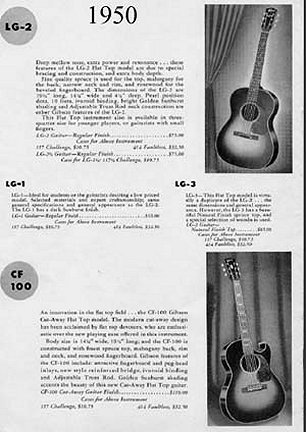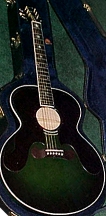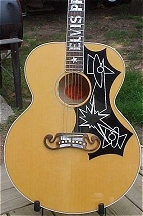 AMERICAN
CLASSIC: THE GIBSON GUITAR AMERICAN
CLASSIC: THE GIBSON GUITAR
The guitar is the most influential instrument in popular music and
no one has built them better than Gibson
BY JIM McCRAW
A hundred years ago Orville Gibson was a salesman and clerk -- by day.
At night and on weekends he was a craftsman, building some of the most
innovative and unusual stringed instruments the world had ever seen.
From his workshops in Kalamazoo, Michigan, he turned out gorgeous instruments,
mostly constructed of old furniture woods--walnut, maple, spruce, and fir--that
had been cut to size and finished.
Gibson was a self-educated builder with bold ideas, the most notable
of which was a one-piece-back and arched-top design that he used for mandolins,
lutes, banjos, and guitars as early as 1895. His instruments from this
era are known for their star-and-crescent logos, inlaid butterfly pickguards,
beautiful
filigree, and warm, full tone.
Gibson sold his company in 1902 to a group of Kalamazoo businessmen,
then sat back and watched it grow into a pivotal element in the rebirth
of American popular music--ragtime, jazz, big band, blues, country
and western, bluegrass and, of course, rock and roll. Today, Gibson guitars
are as much cultural icons as the superstar musicians who play them.
Though Gibson's current fame rests on the legendary status its electric
guitars, much of the company's early success was due to its groundbreaking
designs in acoustic stringed instruments, especially the archtop guitar.
Of these, the Lloyd Loar-designed Style 5 Master Model guitar of 1923 is
probably the most celebrated. Known as the L-5, this guitar pioneered the
concept of building a specific pitch into the sound box by tuning the f-holes,
air chambers, and other structural components.
Gibson's reputation in the 1930's and '40's rested on another trailblazing
guitar, the big 18"-wide Super 400 archtop. This guitar set new standards
for size, quality of craftsmanship, and decoration. Fitted with optional
pickups, it marked the transition into the age of electric guitars. A modified
version of the Super 400 became Gibson's first successful electric model
in 1951, and Bill Haley used a variation of it to Rock Around the Clock.
Of all the dozens of guitar models bearing the Gibson name over the past
century, however, the Les Paul solid-body electric stands out from the
rest as the most important.
The company has dabbled with electric guitars since 1935, when it introduced
the aluminum-bodied Electric Hawaiian Guitar. This model used crude magnetic
pickups made with thousands of wire windings to literally "pick up" vibrations
off the guitar strings and send them through a cable to an amplifier
/ speaker. Vibrations from the strings disturbed the pickup's magnetic
field and created small amounts of alternating current that could be reproduced
by the amplifier as sound. Early pickups were typically placed in the air
chambers of hollow-body guitars.
One musician, however, reasoned that by using improved pickups, he could
dispense with the air chamber to create a thin-bodied guitar far more comfortable
to play than the big-bodied designs of the day. He decided to take the
sound waves directly from the strings for a purer, cleaner, and brighter
sound, without the overtones that hollow-body electric guitars typically
produced. These factors were important to him because he was interested
in using the guitar as a lead solo instrument, not simply as part of the
rhythm section.
To make his dream a reality, he made his first pickup from the tone
arm of a phonograph and his first amplifier from components cannibalized
from a Bell & Howell movie projector. His name was Lester William Polfuss,
who had been playing professionally since the age of 15 under the stage
name Rhubarb Red. In later years, he became known simply as Les Paul. The
Grammy-award-winning entertainer is also the electronics wizard credited
with the invention of sound-on-sound multiple recording, echo effects,
layering, phasing, and eight-track recording.
With his wife and partner, singer and guitarist Mary Ford, he had a
long string of hits in the late 1940's and 1950's.
In 1939, Les Paul had built a prototype he fondly dubbed "The Log."
It consisted of a Gibson guitar neck attached to a 4"x4" block of pine
and fitted with two pickups, one for treble and onefor rhythm. It could
be played as it was, but to make it look more like a real guitar, he bisected
the body of an Epiphone f-hole acoustic guitar and glued the two pieces
around the central log. Two years later, he lugged his 20-pound prototype
to the folks at Gibson, whose guitars he had been endorsing since 1928.
They flatly rejected the idea.
After World War II, however, Leo Fender, a radio repairman from Anaheim,
California, introduced the all-maple, solid-body electric guitar that came
to be known as the Fender Telecaster. By the late 1940's, Fender solid-body
electrics were so successful that Gibson made up his mind to to revisit
the idea behind "The Log," resulting ultimately in the issue of the first
Gibson Les Paul in 1952.
The original Les Paul had a maple cap on top of a mahogany back and
neck, a striking gold paint job, a cutaway in the lower half of the body
so that players could easily reach the highest notes, and a sculptured,
arched center section on the body. In contrast, the Fender Telecaster of
that era was a flat slab of ash with a natural finish. The Les Paul used
two adjustable pickups with separate volume and tone controls for each.
It also had a 3-way tone toggle for switching between and combining the
two pickups, cream-colored plastic pickguard, and pickup covers, and a
long trapeze bridge piece at the bottom. A patent was filed on January
21, 1953.
After introducing the first Les Paul model, Gibson never stopped refining
the design, and Les Paul provided input on most of the changes. A "stop"
tailpiece replaced the trapeze tailpiece in 1953. In 1954 the Les Paul
Custom was introduced, painted in black and trimmed in white to resemble
a tuxedo. It became an instant hit, and was later known as "Black Beauty"or
"The Fretless Wonder" because of the ease with which it could be played.
A new type of tailpiece that included a tuneable bridge design (the
Tune-O-Matic) was introduced on the 1955 models. In 1957, Gibson introduced
"humbucking" pickups. Whereas most pickups had one coil, humbuckers had
two -- one with positive polarity and the other with negative, set
on opposite sides of a magnet. This arrangement cancelled, or "bucked,"
the annoying electrical hum that was produced when the instrument was placed
too close to an amplifier or microphone. Between 1957 and 1961, the Custom
came with three pickups. In 1958 there came a cherry-edged flamed-maple
top.
By 1961 rock and roll was sweeping the world and the Les Paul adopted
a more modern, sharp-pointed, double-cutaway design. The best-sellers of
this era were:
The Custom (three pickups and a tremolo attachment),
The Standard (two pickups, with or without tremolo),
The Special (two single-coil pickups), and
The TV (single pickup).
Despite the success of these models, however, Les Paul's development
contract with Gibson was not renewed after 1962 and the model name was
changed to SG (for solid guitar). His departure raised howls from the Les
Paul faithful all over the world.
Les Paul re-signed with Gibson a few years later and the original single-cutaway
designs were reissued. Ever since, there's been a steady stream of designs
such as the Artisan, Artist, Classic, Deluxe, Heritage, Jumbo, Lite, Plus,
Signature, and Studio, to name just a few of the nearly 50 models. Each
has is own distinct shape, color, electronics, and fittings.
Since they were first issued in 1952, nearly every great guitarist from
Chet Atkins to Frank Zappa has played a Gibson Les Paul. Some have collected
dozens and Gibson estimates that nearly 500,000 have been built and sold
over a period of 43 years.
Guitar authority and collector George Gruhn of Gruhn Guitars in Nashville,
Tennessee, reports that the most desirable model of all is the Les Paul
Standard made between '58 and '60, in cherry-finish and flamed-maple models
with humbucking pickups. Only about 170 were made and he figures they are
worth between $25,000 and $70,000. He notes that the '57-'58 Gold-Top Les
Paul Standard plays every bit as well, but isn't as desirable or collectible
because of its conventional gold finish. Even this model, however, fetches
about $20,000 today.
So what is Les Paul's personal ax? When the 80-year-old pioneer (who
will issue three more albums in 1996) heads out for a gig, he favors a
1980 Les Paul Heritage Elite that he personally modified. "Gibson just
sends me the box and the neck and a box of parts." he said. "I build the
electronics myself. I still wind the coils on the pickups and solder all
the connections to get the tailored sound that I want for fine-fidelity
speaker systems." He has hundreds of guitars in his Mahwah, New Jersey,
laboratory, each numbered so that he can keep track of the electronic modifications.
Perhaps the best news for guitarists is that Les Paul and Gibson are
at work on a brand-new guitar design that will incorporate new solid-state
electronics. One thing that won't be altered, however, is the legendary
shape that began rocking the music world in 1952.
|


.
.
Sue-On has always allowed, and even encouraged, me to indulge in what often turn out to be expensive pursuits in the name of music. Despite my appreciation of guitars, I made it almost into the 21st century without ever owning, or even playing, a Gibson instrument. Strange, as so many of my favourite players and so much of the music I've listened to are associated with Gibson guitars.










